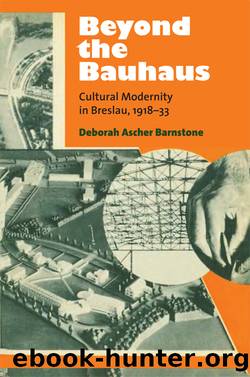Beyond the Bauhaus: Cultural Modernity in Breslau, 1918-33 by Deborah Barnstone

Author:Deborah Barnstone
Language: eng
Format: epub
Publisher: University of Michigan Press
Published: 2018-01-15T00:00:00+00:00
Page 133 â
Chapter 5
Between Idealism and Realism: Architecture in Breslau
âThe sensuous and the spiritual, which struggle as opposites in the common understanding are revealed as reconciled in the truth expressed by art.â
âC. W. F. Hegel, On the Arts
Fragmentation and variety were defining characteristics not only of Breslau art in the 1920s but also of architectural design. Iain Boyd Whyte and others have argued that, like its art, German architecture of the time responded to the âcontradictory conditions of modernityâ by neatly dividing into opposing camps organized around traditional and modern values.1 But Breslauâs architects do not fall easily into either camp; instead, they touch on both. Breslau thus provides a useful case study for correcting simplistic notions of binary division in German architecture. On paper and built, the work of Breslau architects may be disjointed and multivalent, but it is also rich in content and invention. The term âBreslau workâ needs to be carefully defined, however. Only a handful of outstanding buildings designed by architects who worked in the city were actually constructed in and around Breslau; most of their best work was commissioned by clients in other cities in Germany and abroad. This was a twin consequence of the economic situation in the 1920s, which constrained private construction, and the relative cultural conservatism of many Breslauers of means. As the economy stabilized and Silesia began to recover from the war, building activity predictably picked up, but by the time of the crash of 1929 it still had not reached prewar levels. Much of the interwar architectural production in Breslau was therefore speculative and never constructed. However, unbuilt designs can be as revealing as built ones, for architecture exists not only in the physical world but on paper as well. Competition entries, visionary utopian designs, and drawings of unrealized work can tell us as much about the variety of practice as architectsâ writings and actual buildings.
Page 134 âBreslau architects whose work demonstrates the incredible variety of approaches during the Weimar period include Richard Konwiarz, Heinrich Lauterbach, Adolf Rading, Hans Scharoun, Max Berg, Moritz Hadda, Albrecht Jaeger, Heinrich Tischler, Hugo Leipsiger, and Ludwig Moshamer. Lauterbach, Hadda, and Leipziger were all Breslau natives; Jaeger and Tischler were Silesians; and Berg, Konwiarz, Moshamer, Rading, and Scharoun came from other parts of Germany. Rading and Scharoun initially moved to Breslau to teach at the Academy, while Berg, Konwiarz, and Moshamer came to the city to work for the Breslau Municipal Housing Office and did private work on the side. Only Lauterbach, Rading, and Scharoun are associated with the Neues Bauen (New Building) of the 1920s, though Lauterbach and Rading rejected the label, while Scharoun is usually set apart by art historians because of his idiosyncratic work. All these architects were open to multiple theoretical and formal possibilities and willing to marry positions usually understood as mutually exclusive. The aesthetic identity they assumed was an amalgamation of traditional and modern tropes. In many cases, they derived their traditional architectural values from direct study of local
Download
This site does not store any files on its server. We only index and link to content provided by other sites. Please contact the content providers to delete copyright contents if any and email us, we'll remove relevant links or contents immediately.
Wonder by R.J. Palacio(8430)
Mastering Adobe Animate 2023 - Third Edition by Joseph Labrecque(3707)
Unlabel: Selling You Without Selling Out by Marc Ecko(3574)
Ogilvy on Advertising by David Ogilvy(3482)
Hidden Persuasion: 33 psychological influence techniques in advertising by Marc Andrews & Matthijs van Leeuwen & Rick van Baaren(3454)
Drawing Cutting Edge Anatomy by Christopher Hart(3437)
The Pixar Touch by David A. Price(3344)
POP by Steven Heller(3297)
The Code Book by Simon Singh(3055)
The Art of War Visualized by Jessica Hagy(2932)
Slugfest by Reed Tucker(2923)
The Curated Closet by Anuschka Rees(2896)
Rapid Viz: A New Method for the Rapid Visualization of Ideas by Kurt Hanks & Larry Belliston(2813)
Stacked Decks by The Rotenberg Collection(2796)
365 Days of Wonder by R.J. Palacio(2737)
The Wardrobe Wakeup by Lois Joy Johnson(2717)
Keep Going by Austin Kleon(2681)
Tattoo Art by Doralba Picerno(2582)
Tell Me More by Kelly Corrigan(2579)
